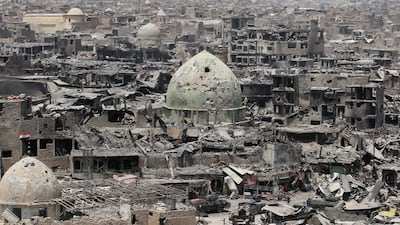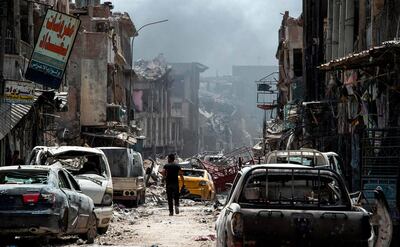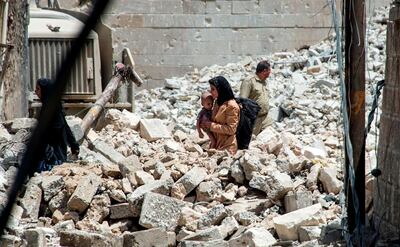The battle for Mosul lasted nine months but could have been won much faster. The high cost of victory came down to a simple decision. For the first time in nearly four years' fighting across 40 operations, Iraqi forces did not leave a back door for ISIS fighters to withdraw from Mosul.
That decision now provokes mixed feelings among military commanders, coalition officials and foreign diplomats who spoke to The National in Mosul, Raqqa and Kuwait about how Mosul became one of the worst urban battles since the Second World War and what the alternatives might have been.
Most of these sources requested anonymity to freely discuss a sensitive topic and many reached the same conclusion: The decision to encircle Mosul was difficult but it ensured victory was total.
In the original battle plan, advancing Iraqi forces would leave a route open to the west into neighbouring Syria. Macabrely labelled “the kill box”, fighters and their families fleeing through this area would have been targeted by coalition air strikes.
But Iran, anxious that ISIS fighters might sweep back into Syria just as its ally President Bashar Al Assad was gaining the upper hand in his country’s civil war, wanted ISIS eliminated in Mosul, Reuters reported.
In November 2016, with the battle for Mosul well under way, Iran’s militia proxies in the Popular Mobilisation Units sped into the desert west of the city, turning Mosul into a siege.
“When we closed the door, it was very nasty business,” one coalition officer said. “To choose where you eradicate an entire people is a tough decision. For the final five months in Mosul — no golden path to leave. In all other operations this was allowed.”
The United States-led coalition acquiesced to the new reality on the ground, aware that if ISIS were allowed to escape as in previous battles, it would regroup along the Syrian-Iraqi border where the coalition had limited operational capabilities, a senior western diplomat said.
Contrary to their propaganda, ISIS never intended to fight to the death. In Mosul, the group tried to negotiate an escape via tribal leaders working as intermediaries.
“They tried to negotiate a surrender that was unreasonable: keeping weapons and being allowed to walk out of the city with all their people armed,” a coalition officer said. “It was denied.”
_________
Read more:
Cellist brings sounds of peace to former ISIS capital
Living in the shadows: Yazidi women tell of ISIS hell
Angelina Jolie decries 'appalling' conditions in Mosul during visit to Iraq
_________
By early 2017, surviving fighters were besieged in Mosul’s Old City along with thousands of civilians. There on the western bank of the Tigris River, the brutal battle took an even darker turn.
A year on, the Old City remains in ruins. On a recent evening the setting sun bathed the rubble in purple light. Standing on the opposite bank of the river, a group of Iraqi soldiers guzzled whisky while music from a nearby wedding blasted into the dusk.
One of the soldiers, his face scarred by shrapnel, recounted the final days of fighting. “Around 15 per cent of the civilians managed to flee, the others are in there,” he said, pointing to the murky waters of the Tigris. “We had to kill everyone. We couldn't tell friends from enemies.”
Today the remaining stench of death reminds the few returning survivors that the Old City is now an ossuary. Bodies are still being retrieved.
“Looking back,” one Iraqi commander said, “we should have let ISIS escape.”
Allowing ISIS to escape was a strategy used both before and after Mosul.
During the battle for Fallujah in June 2016, US officials privately opposed the Iraqi tactic of leaving ISIS an escape route when besieging a city. One American officer allegedly told his Iraqi counterparts they were “cowards” for not wanting to finish off the ISIS fighters, the western diplomat said.
When fighters fled along the route left open to them, their convoy was attacked by coalition air strikes and Iraqi helicopter gunships.
In Raqqa, once the most important ISIS stronghold in Syria, fighters were allowed to leave with their weapons and families, in buses provided by the US-backed Syrian Democratic Forces. The convoy included some of the group’s most notorious surviving members alongside dozens of foreign fighters. They later spread out across Syria, making it as far as Turkey, BBC reported.
“It was the best decision. Without that deal, my daughter and son would have died,” said one Raqqa resident, whose adult children were detained in Raqqa by ISIS fighters.
“They were injured, but at least they are alive,” the mother said. “Too many civilians died. They should have struck that deal way earlier.”
One could argue that Iraqi officials could have saved lives by applying the same logic in Mosul. But if they had, more ISIS fighters would have remained to hold civilians hostage elsewhere.
There is no obligation under international humanitarian law to allow combatants an escape route, said Dustin A Lewis, a senior researcher at the Harvard Law School Programme on International Law and Armed Conflict. “An obligation is on ISIS to protect civilians or let them leave safely, and another obligation is on the other side to take constant care to spare civilians in conducting military operations against ISIS."
And even though thousands of civilians died in Mosul, the death toll could have been higher. One million more were moved to safety in what the United Nations has called the largest managed evacuation from a combat zone in modern history.
“Hundreds of thousands miraculously made it out alive,” the western diplomat said. “That's what matters.”



